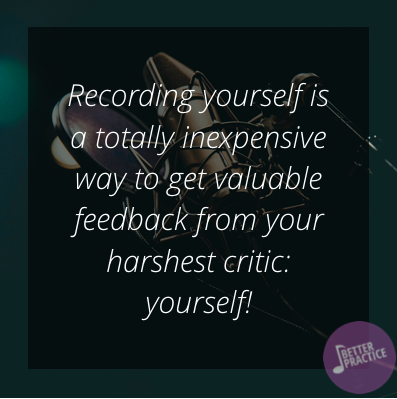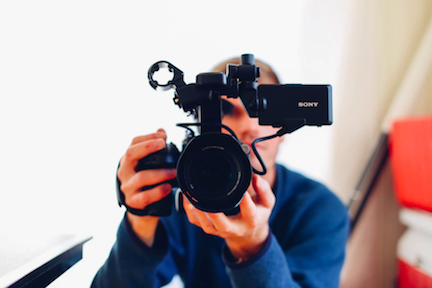If you are a musician or working on becoming one, you need to be recording yourself. It doesn’t matter if you’re just learning, a holiday performer for your family, or a concert musician. Incorporating recording into your practice can only help you, and it’s a totally inexpensive (if not free) way to get valuable feedback from your harshest, most honest critic – yourself!
Why should you record yourself?
1. Separate playing and evaluating. Often when you’re practicing, you’re practicing while simultaneously evaluating yourself. For example, as you’re playing through a big piece for practice, you’re taking mental notes: “I forgot to lift my wrist here. I missed that tempo change. I have to get quieter at this section.” You’re not going to remember all of these things, nor do you want to stop in the middle of your run-through and write each and every note down. With a recording, you can play as you would in an actual performance (in the moment) then worry about evaluating after. This way, you get a more realistic recording, and you can replay the recording as many times as you want later with a notepad in hand to pinpoint all of the errors or spots you want to fix.

2. Track progress. What did you sound like a month ago? A year ago? Most likely, you don’t really know. At most, you have a vague idea of what level you were at, or what skills you had. Seeing improvement can be a really great motivator (especially for growth-/achievement-motivated types), but you can’t see it unless you record yourself regularly. Better Practice is great for storing recordings – you can store them all together or store them by song so you can see a timeline of your improvement for that specific song.
3. Get feedback from others. These days, it is easy to share your recording with others. Now, you don’t have to gather a bunch of people to get feedback on your playing. Share your recordings and, as scary as it might be, send it to your friends/mentors/teacher or post it on social media to ask for feedback! It’s a super quick and easy way to get feedback from others’ points of view, which can provide a lot of valuable insight.
4. Hear and see as the audience does. You know how you want to look or sound on stage – in other words, you know what kind of artist you want to be. But you’ll never know for sure if your audience sees you the same way you think you’re performing unless you put yourself in your their eyes. If you hate seeing recordings of yourself like I do, it may be painful at first, but it’s those parts that make you cringe that you need to weed out. Remember: it’s better that you catch (and fix) any embarrassing habits before your audience does! “I’m doing that with my leg??” or, “I thought I crescendoed more there.” If it doesn’t fit your image of what you thought you were doing, fix it! Eventually, you want to be able to watch your recording and think, “I nailed it.” Because then, that’s most likely what your audience will think, too!
5. Performance practice. Recording yourself is great performance practice because you want to get as good a recording as possible. If you’re trying to submit a recording, you’ll probably end up practicing until you can play it through with no mistakes and avoid stopping (for the best recording possible!). You also get that sense of “Here we go – this is it” when you hit that red record button, which is really a slightly watered-down version of what you feel on performance day.

Visual or audio recordings?
1. Audio only. Audio only can be great for really refining the musicality aspect of your playing. Tone, dynamics (and the exaggeration thereof), phrasing, breathing, etc. can be really focused on with an audio-only recording. Sit down with a notepad, put your headphones in, and really think about what you want to hear coming from yourself vs. what you actually hear. Make note of everything that irks you, even the slightest bit. It’s up to you to decide how much detail you want to go into – you can listen through it multiple times if you have a very specific way you want to sound, or, just go through it once or twice and pick out what stands out to you.
2. Visual. This is where you can refine your movements/posture and catch any weird habits you may have that you want to fix. Maybe you see that you drop your elbow really low when you get to a certain range on the piano, and it looks like it’s hindering your playing. Maybe you’re bending forward whenever you try to hit a high note and that might be what makes your high notes inconsistent. Maybe you find you kick your leg out to the side every time you hit a big chord – and you love that weird habit! Either way, becoming aware of what you’re doing helps you be more aware of what you are communicating to the audience. How is your posture or your technique? If it’s a classical competition or exam you’re preparing for, you’ll definitely want to watch that.
Recording can be trickier for piano players, who can’t just place the camera on the stand and take a couple steps back. Here’s how to get the best angles for piano.
Recording tools
You can use almost any device in this day and age to record (for better or for worse). Your phone most likely has an audio recording app and a camera. So does your laptop and tablet. Another obvious option is a camera or camcorder. Even if you have a desktop computer, you can hook up a cheap mic and/or webcam and record from there. If you are reading this article, you can probably record. Get to it and become a better performer in no time!
Unleash your inner critic! Tracking progress with recordings has never been easier with Better Practice. See how far you’ve come across the weeks, months, or even years with your recordings in one place.